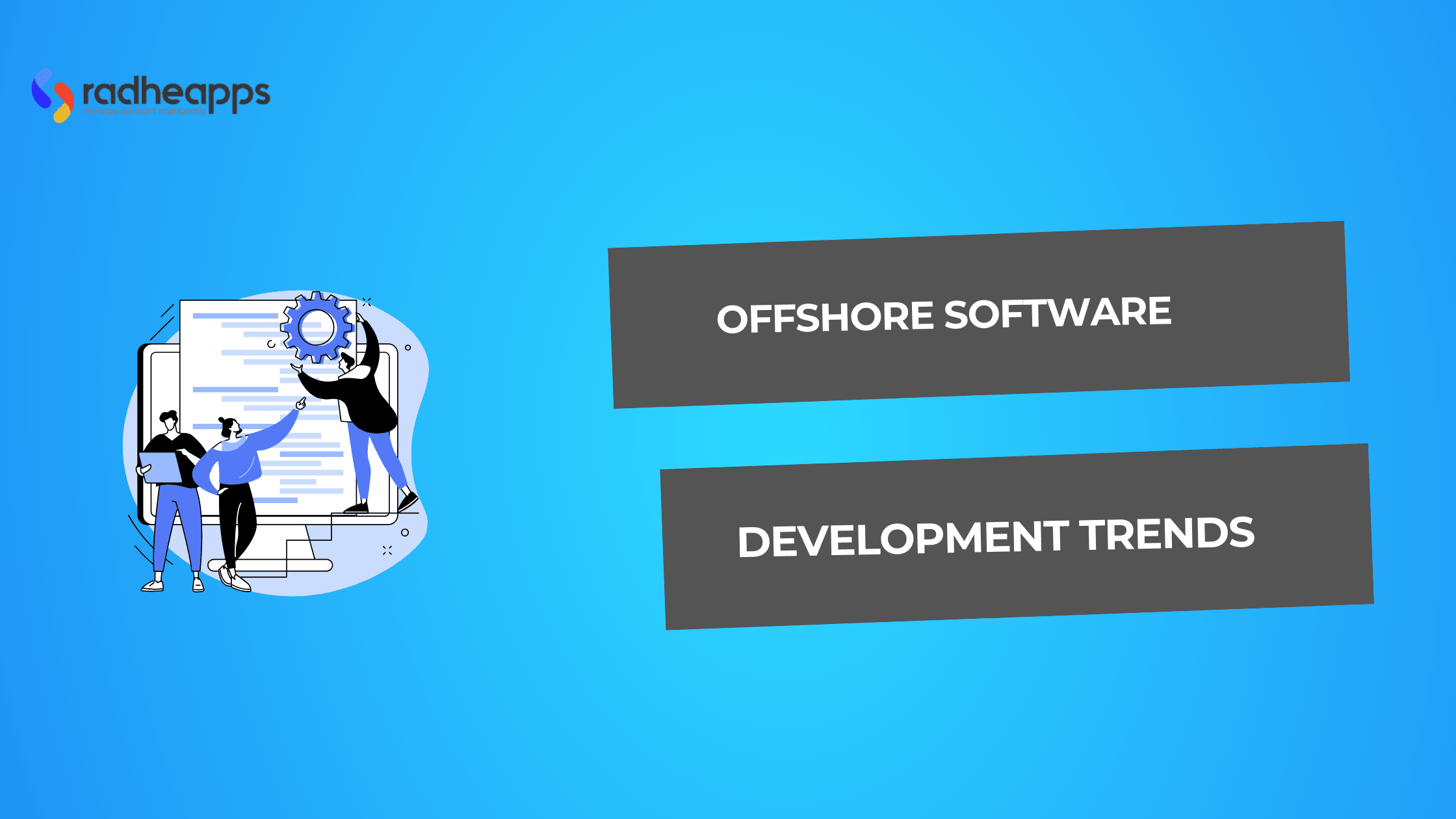Businesses are now seeking more innovative ways to be competitive in their industry. They are optimizing their cost and maximizing their efficiency in creative ways. The answer to all this is offshore software development trends.
These trends have transformed development by cutting costs and have become an accelerator of innovation, scalability, and global collaboration. Offshore software development allows companies to collaborate with skilled professionals worldwide to access specialized expertise.
It helps the team gain an advantage by quickly launching their products. From startups to Fortune enterprises, businesses employ offshore development teams to build robust applications. It provides emerging technologies and fosters streamlined operations beyond the limits.
What makes offshore software development stand out? How can a business overcome challenges like globalization and depth security concerns to get the most out of it?
We have your back. With the RadheApps team, you will discover offshore development benefits, best practices, future trends and actionable insights. We will help you to unleash offshore teams’ power with secured development sources.
We are one of the industry’s top software and mobile app developers. We also provide services such as app development consulting. Our experienced app and web development team can help you with all offshore development solutions.
This blog delves deep into whether you’re just getting started or planning it. Partner with RadheApps today to equip ourselves to innovate globally and create anchors that transcend borders.
TL;DR- Offshore Software Development Trends
- AI-Powered Development
- Low-Code and No-Code Development
- Cloud-Native Development
- Cross-Platform App Development
- Business Process Automation (BPA) and Digital Transformation
- Focus on Cybersecurity
- Agile Development and DevOps Adoption
- Specialized Talent in Emerging Technology
Top Offshore Software Development Trends
The offshore software development industry is transforming how companies meet the requirements of tech sources. Companies are searching for new ways to stay competitive by delivering high-quality solutions quickly without investing much. Let’s take a look at the significant trends of offshore technology.
AI-Powered Development
Artificial intelligence (AI) has revolutionized software development with innovative, quick, and practical resources. Offshore teams leverage AI tools for predictive analytics, code generation, and automated testing.
AI increases productivity by minimizing errors and letting developers spend more time on high-value work. AI-generated coding mandates a personalized user experience, which is pivotal in today’s customer-centric marketplace.
Low-Code and No-Code Development
Low-code and no-code platforms are in high demand because they speed up application development and deployment. This type of software requires almost no code to build.
Offshore development teams are increasingly adopting these platforms to enable non-technical industries to build their applications. This has become beneficial for startups and SMEs that want to scale quickly without considerable investments in development resources.
Cloud-Native Development
Cloud-native development is becoming the norm as organizations move to cloud servers for scalability and flexibility. Offshore development teams emphasize building custom web applications optimized for cloud infrastructure.
The microservices architecture allows for consistent scalability, decreased operational costs, and enhanced application performance. Cloud-native development also aligns with the worldwide move toward remote work.
Cross-Platform App Development
Cross-platform app development companies have extended offshore for multiple devices and operating systems. Offshore developers increasingly use frameworks such as Flutter, React Native, and Xamarin to ensure seamless application access via cross-platform.
| Read more: Learn how React and React Native work for different development processes. |
This trend conserves time and money to ensure a consistent user experience – critical for brand loyalty and customer retention.
Business Process Automation (BPA) and Digital Transformation
The same can be seen in other cases where offshore software development teams are recruited for digital transformation initiatives. BPA tools automate repetitive tasks, cut operational costs and enhance overall efficiency.
The essential role of offshore developers includes implementing robotic process automation (RPA) and building machine learning models. This provides advanced analytics that enables process efficiency and actionable insights. This enables firms to focus on changes in innovation and strategic improvement.
Focus on Cybersecurity
Cybersecurity is a significant priority in offshore software development. Development teams implement robust security measures at each stage of the software lifecycle.
From secure coding practices to advanced threat detection systems, offshore teams help businesses secure customer data.
Agile Development and DevOps Adoption
Agile development and DevOps processes have become remedies in offshore development. They smooth collaboration, efficiency, and project performance. Agile captures new requirements quickly, while DevOps maintains an environment for continuous integration and delivery (CI/CD).
They allow faster deployment and high-quality applications. Offshore teams utilize advanced project management and communication tools. This helps them ensure seamless coordination across time zones.
Specialized Talent in Emerging Technology
Technologies like blockchain, the Internet of Things (IoT) and extended reality (XR) need specialized expertise. Offshore development companies are investing in upskilling their teams to meet the niche demand.
This specialization allows businesses to access cutting-edge technology without going through an excessive build-out of internal resources. Staying ahead in innovation is getting easier with offshore development, thanks to cost-effectiveness.
How to Choose the Right Offshore Software Development Partner
Offshore partners can bring multiple benefits including cost efficiency and faster project delivery. Choosing the right partner is crucial to ensure project success. Here’s a step-by-step guide to help you get the ideal offshore software development partner:
| Criteria | What to Look For | Why It Matters |
| Define Goals and Requirements | Clearly outline project objectives, scope, timeline, budget, and key deliverables. | Ensures alignment and helps the partner understand your vision. |
| Evaluate Technical Expertise | Assess skills in programming languages, frameworks emerging technologies, AI, blockchain and cloud platforms. | Confirms the partner can handle your specific technical requirements. |
| Communication and Collaboration | Check for regular updates and transparent communication tools like Jira or Trello in your preferred language. | It avoids misunderstandings and ensures smoother execution. |
| Cultural Compatibility | Look for a team that aligns with your business values, adapts to your work style, and respects deadlines and quality standards. | Promotes a strong working relationship. |
| Security and Compliance | Verify adherence to GDPR, HIPAA, secure coding practices, data encryption, and willingness to sign NDAs. | Protects your intellectual property and ensures regulatory compliance. |
| Track Record and Reputation | Research testimonials review on platforms like Clutch, retention rates, and post-delivery support capabilities. | Provides insights into the partner’s reliability and quality of work. |
| Team Structure and Resources | Evaluate team size, expertise, and access to advanced tools and technologies. | Ensures the partner has adequate resources to handle your project efficiently. |
| Cost vs. Value | Look for competitive, transparent pricing and a balance between cost and quality. | It avoids hidden costs while ensuring high-quality deliverables. |
| Pilot Project | Start with a small test project to assess technical and communication skills and their ability to meet deadlines. | It helps you build trust and evaluate capabilities before committing long-term. |
| Post-Delivery Support | Ensure the partner offers maintenance, bug fixes, updates, and scalability options. | Ensures long-term success and adaptability to future needs. |
This table format offers a quick and structured overview to help you effectively evaluate offshore software development partners.
Best Practices for Managing Offshore Teams
Implementing these offshore management tricks can create a productive and innovative working environment. It drives successful project outcomes and fosters long-term partnerships.
| Best Practice | Description | Why It Matters |
| Clear Communication | Maintain communication channels with tools like Slack or Google Meet to ensure regular updates through meetings or reports. | Creates understanding and keeps everyone aligned with the goals and progress. |
| Set Expectations Early | Define project goals, roles, responsibilities, deadlines and deliverables from the start. | It Provides clarity and avoids any type of confusion for smoother collaboration. |
| Cultural Sensitivity | Be aware of cultural differences, work ethics, and time zones to foster respect and understanding. | Builds stronger relationships and a positive working environment. |
| Use Project Management Tools | Use management tools like Jira, Trello or Asana to assign tasks and track progress. | Ensures transparency across the team. |
| Regular Check-Ins | Schedule daily or weekly meetings to discuss progress and blockages. | Keeps the team on track and resolves potential issues early. |
| Invest in Team Building | Organize virtual team-building activities or occasional in-person meetups when feasible. | Builds trust and improves collaboration within the team. |
| Provide Training and Resources | Provide training on tools and resources to help the team stay updated on the latest technologies and trends. | Keeps the team skilled and motivated to improve overall performance. |
| Focus on Results, Not Hours | Emphasize deliverables and outcomes instead of micromanaging work hours. | Boosts productivity and promotes autonomy among team members. |
| Establish Time Zone Overlaps | Plan work schedules to include some overlapping hours for real-time discussions and collaboration. | Facilitates better coordination and faster decision-making. |
| Recognize and Reward Performance | Acknowledge team achievements through public recognition, bonuses, or appreciation emails. | It enhances morale and motivates the team to perform at their best. |
| Maintain a Feedback Loop | Encourage regular feedback from the offshore team and provide constructive input to improve processes and collaboration. | Builds a culture of continuous improvement and strengthens the partnership. |
| Ensure Strong Leadership | Appoint a dedicated manager to oversee the offshore team and serve as the main point of contact. | Streamlines communication and ensures the team remains aligned with project goals. |
| Focus on Documentation | Maintain thorough documentation for processes, project requirements, and code repositories. | Provides clarity and ensures continuity if team members change or transition. |
| Build Trust Gradually | Start with smaller projects to build confidence in the team’s capabilities before scaling to more significant initiatives. | It helps establish trust and ensures smooth collaboration in the long run. |
You can start implementing these activities regularly to bring out most of the productivity.
Future of Offshore Software Development
The offshore software development industry is changing the dynamics of tech world markets. Here are some of the trends and factors that will play an essential role in shaping the future of this sector:
Greater Use of Modern Technologies
Offshore development will play a significant role in technologies such as artificial intelligence, blockchain, quantum computing and the Internet of Things (IoT). Many businesses are now adopting offshore teams to gain niche capabilities and stay competitive.
Focus on Cloud and SaaS Solutions
Offshore teams will be focused on building cloud-native scalable applications. They provide software-as-a-service solutions to businesses operating in hybrid or multi-cloud environments. They have the best SaaS builder tools in the market.
Bespoke Solutions through AI and Automation
Offshore developers can solve software and app problems through AI and high-end automation. Teams use predictive analytics, machine learning and robotic process automation with the help of AI. This helps developers to build some of the most innovative and intuitive systems.
Increase in Demand for Cybersecurity
As cyber threats become more complex, the future of offshore development will involve tighter integration of security measures. Offshore partners will be expected to offer robust cybersecurity services and comply with stringent global regulations.
Hybrid Work and Distributed Teams
Remote and hybrid work models will solidify offshore teams’ position as integral to global operations. Businesses will prioritize collaboration tools, time zone management, and flexible processes to ensure seamless integration of offshore talent.
Concentration on Sustainability
From now on, more about these offshore teams will make green and energy-efficient applications. This will keep pace with environmental standards and corporate social responsibility goals.
The Shift Towards Value-Driven Partnerships
The emphasis will shift from cost savings to building value-driven strategic partnerships. Companies seek offshore vendors with technical knowledge, innovation, market insight and long-term collaboration.
Upskilling and Specialization
Offshore software development companies will progressively invest more money in their employees. Retraining them to keep pace with developments in several specialized areas including extended reality (XR), metaverse development and advanced analytics.
AI-Augmented Development Teams
Offshore developers will increasingly adopt AI-based tools into their workflow. This will enhance efficiency and accuracy in coding, testing and deployment.
The shining future of offshore software development has opportunities within it. With innovations, strong partnerships and a specific focus on specialized services, offshore will be a powerful tool in changing technology and global business growth.
Conclusion
The offshore software development process is rapidly transforming due to technological advancements and changing business priorities. Companies can maximize the potential of offshore teams through AI-powered development, low-code platforms, cloud support, and increased focus on cybersecurity.
This trend streamlines processes, reduces costs, and positions businesses for long-term success in a highly competitive market. Offshore software development will have a significant impact. From faster and more accurate research to high-end encrypted data, the IT industry is already increasing trust in offshore development.
But where can you find the best offshore development team for your business? You don’t have to scroll through Google when RadheApps promises you the best offshore development practices. We are not just software developers; we build strategies to get you the best out of offshore development.
Let’s talk. RadheApps always designs and develops what your business needs. Our team has hands-on experience with software, web apps, and offshore development. Visit RadheApps today and boost your limits off-shore
Frequently Asked Questions (FAQs):
How Do Low-Code Platforms Impact Offshore Development?
Low-code platforms significantly impact offshore development by accelerating project delivery times and reducing the need for highly specialized developers on the offshore team.
Why Is Cloud-Native Development Popular?
Cloud-native development is popular because it enables faster innovation, improved scalability, high availability, reduced costs, and greater flexibility.
How Does Business Process Automation Enhance Efficiency?
A planned and modeled business process is the first step to improving efficiency by reducing redundant tasks and activities.




